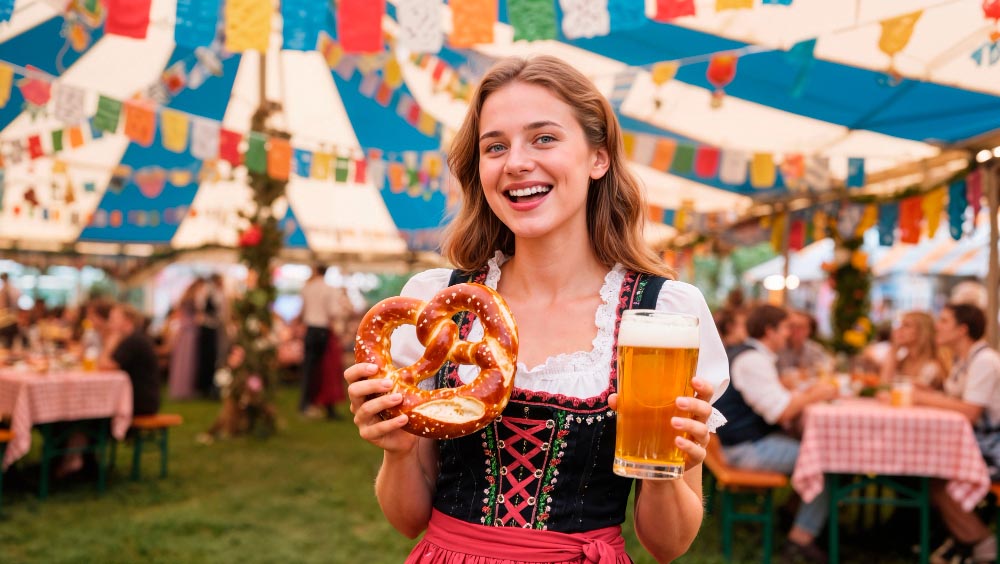Tradition, transformation, and craftsmanship define the lasting appeal of the Bavarian dirndl, which helped shape European fashion identity.
The dirndl has come a long way from its origins as Alpine workwear to a European fashion staple. What started as practical clothing in the 16th century for servant girls now graces the runways of Paris and Milan. This transformation illustrates how Bavarian clothing evolves to take on new cultural meanings over time and how a simple beginning can evolve into a high-fashion statement.
The 500 Year History of Dirndl Evolution
The story moves from mountain villages to urban spaces, from peasant necessity to bourgeois nostalgia, from propaganda to the latest trend.
1500s-1700s: Peasant Workwear in the Alpine Valleys
The dirndl emerged as practical clothing for Alpine working women between the 16th and 18th centuries. Servant girls across German-speaking regions of Austria, Bavaria, Switzerland, and northern Italy needed dresses that were comfortable and allowed full mobility.
The Original Design was Functional
The dirndl was created out of need. A snug bodice saved fabric and let women move freely, while a full skirt made it easy to bend and carry things. The apron kept the skirt clean during daily chores, and a blouse underneath added warmth and coverage.
Each Alpine region had its own style based on what materials were available. Bavarian workers wore darker blues and greens. Austrian areas liked bright reds, while Swiss villages kept things simple with plain cuts and fewer details.
Class Distinctions Appeared in Fabric Quality
The daughters of wealthy farmers wore dirndls made from finer linen and wool. Poor servant girls used coarser materials that withstood harder labour. The dress itself signalled no shame. Everyone from the valley wore some version of it. The quality of construction and fabric revealed economic position within the peasant class.
No urban dwellers wore dirndls during this period. The dress remained confined to rural Alpine communities, invisible to European fashion consciousness developing in Vienna, Munich, and Milan.
1800s: The Romantic Discovery of Authentic Alpine Life
European Romanticism changed how people saw country life. Writers, artists, and thinkers started viewing peasant culture as genuine and pure, far away from the complications of urban living.
Upper-Class Tourism Created New Demand
Wealthy urbanites started visiting Alpine regions during the early 1800s. They encountered dirndls wearing peasant women and interpreted the clothing as charmingly traditional. The dress became associated with an idealized pastoral lifestyle. Some upper-class women began wearing Bavarian dirndls as a costume during Alpine holidays.
The Term Dirndl Emerged from Upper-Class Adoption
The word dirndl comes from Dirn, a Bavarian Austrian dialect term meaning girl or young woman. The term gradually attached itself to the dress through upper class romantic association with innocent Alpine maidens.
Late 1800s: Codification as Official Regional Costume
People started documenting and preserving regional clothing styles to keep these traditions alive with the rise of German and Austrian nationalism during the late nineteenth century.
Folklore Societies and the Invention of Authentic Tradition
Cultural organizations across German-speaking Europe started recording authentic dirndl styles by region. They photographed peasant women, documented techniques, and created official versions representing each area’s traditional dress.
This codification process actually created many traditions that had been fluid before. Folklore societies wanted fixed, identifiable versions that could represent regional identity.
Middle-Class Women Adopted Dirndls for Special Occasions
Middle-class women in Bavaria and Austria began wearing dirndls to festivals, church celebrations, and family gatherings . The dress signaled a connection to regional heritage and rejection of international fashion trends coming from Paris.
This adoption completely transformed the social meaning of the dirndl. The same dress that marked you as a servant in 1750 marked you as culturally aware in 1890.
1930s-1940s: Weaponization by Nazi Ideology
The Nazi regime recognized traditional clothing as a powerful propaganda tool. They promoted dirndls and other tracht as expressions of pure Germanic culture and blood-soil ideology.
The Dirndl Became a Political Symbol
Nazi cultural policy encouraged German and Austrian women to wear dirndls as a rejection of degenerate international fashion and an embrace of völkisch identity.
The dress appeared in propaganda materials showing idealized Aryan womanhood connected to land and tradition. Regional tracht organizations received state support while festivals featuring traditional clothing increased.
Reclaiming Meaning in the Post War Years
The Nazi appropriation created complex associations that would haunt the dress for decades. The dirndl carried tainted associations after 1945. Some rejected it entirely as tainted by Nazi cultural policy.
Others argued the dress predated Nazism by centuries and should be reclaimed from that appropriation. This tension shaped dirndl perception throughout the latter 20th century.
1950s-1970s: Tourism and Oktoberfest Commercialization
Post war economic recovery led to the emergence of mass tourism in Alpine regions. The dirndl transformed again, this time into a commercial product for tourists seeking authentic German experience.
Oktoberfest Became the Dirndl Primary Stage
Munich Oktoberfest, which had existed since 1810, expanded later as international tourism grew. The festival became associated with women’s dirndls and men’s lederhosen as an essential costume.
Beer companies and festival organizers promoted traditional clothing as part of the Oktoberfest experience. Dirndls became available for rent near festival grounds. The dress transformed into a temporary costume rather than actual clothing anyone wore regularly.
Regional Distinctions Blurred in Tourist Markets
While traditional communities maintained specific regional styles, tourist dirndls became generic Bavarian or Austrian with no real geographic specificity. The commercially successful dirndl aesthetic became a simplified, standardized version that appealed to international tourists’ expectations.
1990s-2000s: Revival Among Young Europeans
Surprising demographic shifts occurred in the 1990s as younger Germans and Austrians reclaimed the dirndl. This revival reflected broader trends of ironic nostalgia and heritage reclamation among millennials.
Young Women Wore Dirndls at Festivals
Young university students and professionals started wearing dirndls to Oktoberfest and local festivals, not as costumes but as a real connection to their culture. They looked into regional styles, bought quality pieces, and wore them proudly.
Fashion Designers Began Reinterpreting Traditional Elements
Fashion designers in Munich, Vienna, and Salzburg began creating modern versions of the dirndl. They kept the traditional shape but used new fabrics, colors, and cuts. These updated designs showed up in fashion magazines and high end shops.
Black dirndls emerged during this period, controversial among traditionalists but popular with fashion conscious younger women.
2010s-Present: Dirndl Becomes a Global Fashion Icon
The dirndl entered global fashion consciousness during the 2010s through social media, international Oktoberfest celebrations, and high-fashion reinterpretations.
Heritage Meets High Fashion
The dirndl now stands confidently between heritage and haute couture. You will find it gracing Munich’s Oktoberfest tents, Vienna’s fashion galas, and editorial spreads from Milan to Paris. Designers such as Lena Hoschek, Gottseidank, and Noh Nee have turned it into a statement of individuality and cultural fluency.
Modern Innovations Push Boundaries
Contemporary designers create dirndls in unexpected materials like leather, latex, sustainable organic cotton, and recycled fabrics. They offer mini dirndls that would scandalize traditional communities. They design dirndls for pregnant women, plus size women, and gender nonconforming wearers.
Each innovation generates controversy among traditionalists while expanding who can participate in dirndl culture.
Dirndl Controversy Amid Cultural Appropriation
As dirndls spread globally, debates arose about who has the right to wear them. Some argued the dress belongs specifically to German speaking Alpine communities. Others contended that centuries of evolution had made it a general European heritage. Still others saw it as simply clothing available to anyone.
These debates mirror larger conversations about cultural ownership in a globalized fashion. The dirndl’s working-class origins complicate simple appropriation narratives.
Final Words
The dirndl’s evolution mirrors Europe itself like practical, resilient, endlessly expressive. From humble beginnings to couture elegance, it never lost its essence.
That paradox ensures its future relevance as both a heritage object and fashion playground. The dress becomes a global costume originating from a specific place or culture. It will continue to hold different meanings for different wearers, each claiming their own version of authenticity.
##





